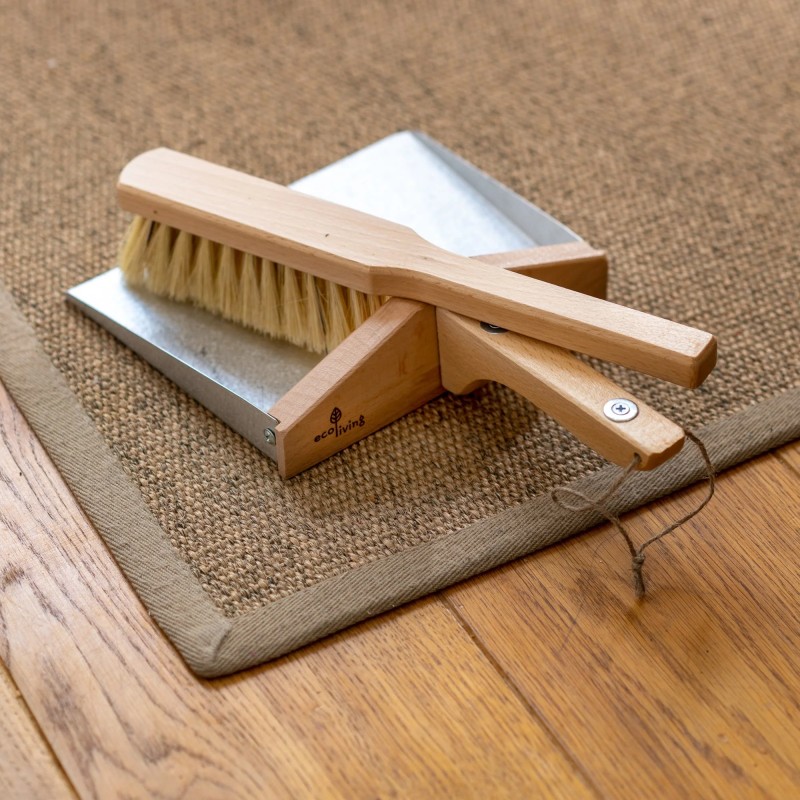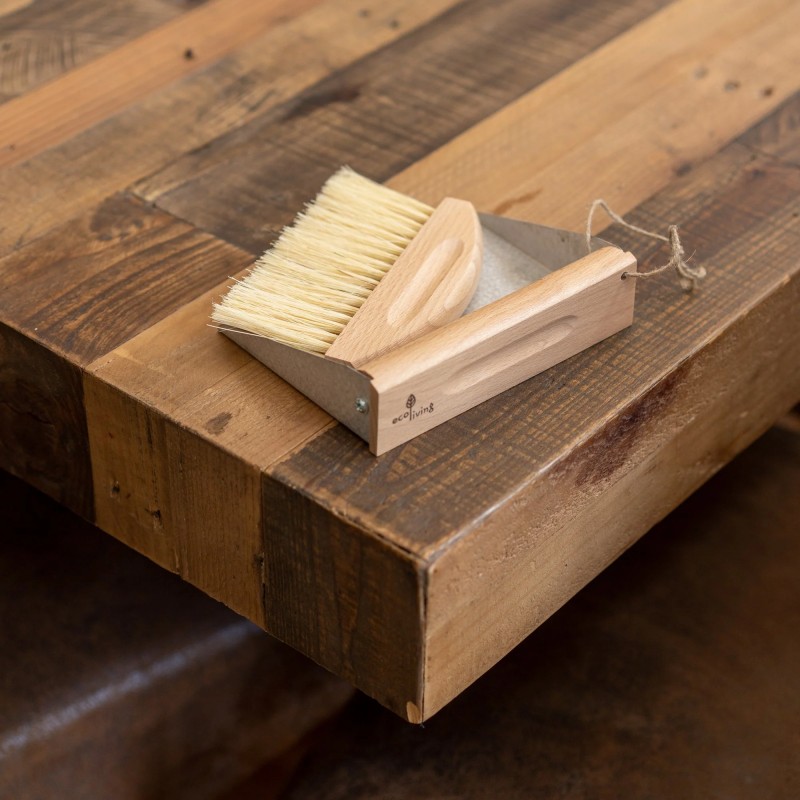
Plastic cleaning tools seem harmless, yet they shed tiny fragments and break with little use. Those fragments often end up in waterways and soil. For a tidy home, a plastic-free dustpan and brush set is a simple swap that delivers.
A well-made set uses natural materials, lasts longer than flimsy plastic, and looks smart in any room. It also avoids the chemical risks linked to plastics, which matters for homes with children and pets. You get reliable dust control and peace of mind.
Don’t Sweep Up Spiders!
House spiders eat flies and won’t do you any harm in England. Garden spiders may come inside in winter, but most house spiders have never been outside, so can’t cope with temperature changes (if you do move one, do so to an unused cupboard ideally, or failing that, a shed or garage.
To prevent spiders, use biodegradable non-scented cleaning routines and vacuum regularly, to deter ‘stale air’. But don’t sweep or vacuum them up. The ‘white fluffy balls’ are spider babies! Read reasons on why not to be scared of spiders!
If you have to remove a spider, gently cover with a cup and slide a piece of card underneath, to release in a quiet indoor area. Carefully move the egg sacs too, to keep mum and babies together!
Help Spiders Trapped in Baths
Spiders don’t come up through plugholes, as this has a water-filled u-bend. But they can’t escape, so again use the cup/card method to trap and release. Or leave a towel over the edge, so your spider friend can climb out to hunt (some people put one over the edge anyway at night, in case a spider falls in).
Why Switch to Plastic-free Dustpans?
Cheap plastic tools wear out fast. Bristles bend, handles crack, and the whole lot ends up in the bin. Each break adds to landfill and can release microplastics that drift into air and water. The cycle repeats, and the cost adds up.
Plastic-free sets take a different path. Many use bamboo, beech, or ash wood, paired with plant fibres like tampico, sisal, coconut, or palmyra. These materials come from renewable sources and do not shed plastic dust while sweeping. They also have a firm feel in the hand, which means better control on hard floors and rugs.
There is a safety gain too. Plastics can leach additives with heat and wear. Natural wood and fibre do not carry the same concerns. For families and pet owners, that lowers risk during daily chores. Natural bristles hold dust well and release it with a tap, so you get a clean sweep without a static cling.
A sturdy wooden handle and tight bristle set create a clean edge at the pan. This helps pick up fine debris like flour, soil, or pet hair. The result is a cleaner home without plastic residue on the floor or in the air. You also support brands that choose sustainable manufacturing, fair sourcing, and long-lasting design.
Environmental Gains from Ditching Plastic
- Less landfill: Durable sets reduce how often you replace tools, which cuts waste.
- Lower ocean pollution: No plastic parts, no microplastic shedding during use or disposal.
- Renewable materials: Bamboo grows fast and wood from managed forests supports regrowth.
- Better habits: Owning solid, appealing tools makes routine cleaning easier to stick with.
Small swaps build momentum. Add a plastic-free dustpan to your broom, compostable bin liners, and refillable cleaners. The household footprint shrinks with each repeat action.
Health and Home Safety Advantages
- No chemical leaching: Wood and plant fibres reduce exposure to plastic additives.
- Easy to keep clean: Natural bristles rinse well and dry fast when spaced properly.
- Allergy support: A firm dusting routine removes fine dust and pet dander. Less airborne irritant means easier breathing, especially during pollen season.
Key Features of Plastic-Free Dustpans

The mini version is perfect for sweeping crumbs off the table.
A good set earns its spot by working hard, not by sitting pretty. Focus on materials, design touches, and ethical sourcing. Match the tool to your floors and habits.
- Plant fibre bristles: Tampico or sisal for general use or coconut for stiffer sweep.
- Ergonomic handles: A smooth, shaped handle improves grip and prevents wrist strain.
- Compact pan edge: Look for a sharp, even lip that meets the floor with no gap.
- Metal or wood pan: Powder-coated steel or beech pans feel solid and resist warping.
- Natural finishes: Food-safe oil or wax protects wood without strong odours.
- Ethical sourcing: Prefer FSC-certified wood or verifiable sustainable bamboo.
A few design options are worth comparing. Bamboo is light and strong, good for daily use. Beech is dense and steady, with a classic look. Coconut fibre is tough on grit and outdoor dirt, while tampico excels at indoor dust.
Durable Materials That Last
Choose woods with a solid track record. Bamboo resists swelling and is highly renewable. Beech and ash offer weight and balance for controlled sweeping. Bristles from tampico keep their shape and do not go mushy when damp.
Avoid mixed plastic inserts or flimsy pan lips. Thin plastic edges bend, which leaves a gap and forces extra passes. A well-fitted metal or wood pan edge keeps contact with the floor.
Look for tight bristle anchoring. The bristle block should not shed clumps with normal use. A drilled, resin-set head or tightly stapled channel signals better build quality.
User-Friendly Designs for Everyday Use
- Comfort grip: Rounded handles and finger grooves reduce fatigue.
- Compact storage: Hanging loops or magnetic clips keep set pieces together.
- Pan capacity: A modest rise stops debris from spilling out when you carry it.
- Compatibility: Match bristle stiffness to your broom and floor type for fewer passes.
- Gentle handling: Use a soft brush for delicate tasks and small creatures.
A thoughtful set becomes part of your rhythm. Hang it near the kitchen, keep one by the back door, and you will sweep more often with less effort.
Simple Cleaning Routines
- Shake out loose dust outside after each use.
- Hand wash bristles in lukewarm water with mild soap, only when needed.
- Rinse, then tap off excess water. Hang the brush bristles down to dry.
- Wipe wooden parts with a damp cloth. Dry straight away to prevent swelling.
- Apply a light coat of food-safe oil on wood every few months to seal out moisture.
- Store in a dry, ventilated spot. Avoid leaving the pan or brush sitting in water.
- Keep the pan edge free of dents. If bent, a gentle press against a flat surface can help.
These habits prevent mould on natural fibres and stop handles from cracking.
Tips for Effective, Kind Cleaning
- Sweep in short, steady strokes toward the pan edge.
- Hold the pan firm against the floor for a clean pickup line.
- For fine dust, use a soft brush and lighter pressure to avoid spreading debris.
- Empty the pan into a bin or compost where suitable. Hair and pure dust go to landfill, plant matter can go to compost if free of glass or metal.
Build a routine. A quick sweep after cooking, a pass in the hallway after wet shoes, and a weekly deep sweep cut dust before it settles.






